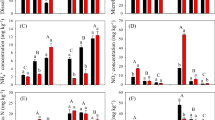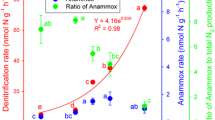Abstract
The denitrifying enzyme activity (DEA), denitrification potential (DP) and anaerobic respiration (RESP) together with chemical characteristics were measured in three contrasting soils collected from experimental arable plots that had been subjected to long-term (21–23 years) fertilizer treatments. The plots sampled were either unfertilized or had received either annual inorganic NPK, manure and lime, or inorganic NPK and manure treatments. Addition of inorganic NPK, manure and lime led to large increases in the DEA for two of the three soils, but in the absence of lime, inorganic NPK and manure caused only small increases in DEA compared to unfertilized soils. Both DP and RESP were increased by the addition of inorganic NPK, manure and lime, but were substantially decreased by fertilizer treatments without lime. In most cases there was a simple relationship between soil pH and either DEA and DP, with those treatments that reduced soil pH also leading to reduced denitrification and vice versa. The effects of artificially increasing the pH to a value close to the pH in unfertilized soils (6.3) by addition of NaOH to the soils that had received inorganic NPK, and which had the lowest soil pH values, were to increase substantially DEA, DP and RESP. In soil from one of the sites that had been stored for 5 weeks, the DP values responded differently between the fertilizer treatments. The DP value was lowest in the soil that had inorganic NPK and manure, higher in the soil that received inorganic NPK, manure and lime and it was the highest in unfertilized (control) soil. The soil pH values for these treatments were 4.47, 5.79 and 6.58, respectively. However, when the soil pHs were adjusted by addition of either H2SO4 or NaOH to give a range between pH 2 and 12, the DP values from all three fertilizer treatments showed almost identical responses. The optimum pH value for DP was between 7 and 8 for all three fertilizer treatments. Substrate-induced respiration values from all fertilizer treatments showed a similar trend to DP when the soil pHs were modified. The results show that soil pH was an important factor which in the studied soils controls the microbial community in general and the community of denitrifiers in particular. However, denitrifiers showed a high pH resilience leading to no marked change of the pH optimum for potential denitrification.
Similar content being viewed by others
Author information
Authors and Affiliations
Additional information
Received: 10 September 1998
Rights and permissions
About this article
Cite this article
Šimek, M., Hopkins, D. Regulation of potential denitrification by soil pH in long-term fertilized arable soils. Biol Fertil Soils 30, 41–47 (1999). https://doi.org/10.1007/s003740050585
Issue Date:
DOI: https://doi.org/10.1007/s003740050585




